For Mushroom Monday this week we have a beautiful little oyster mushroom. Unfortunately though, this is not the oyster mushroom typically found growing on oaks here, that is prized by foragers. This is the ‘mock oyster’ (Phyllotopsis nidulans). I was excited at first glance as I thought perhaps this was a true oyster mushroom, but on closer inspection, it clearly is not.
Phyllotopsis nidulans is a member of the Tricholomataceae family. The Mock Oyster was once placed in the genus Pleurotus, the true edible oyster mushrooms, and it is a convincing look-alike. Don’t be fooled though, this species may be non-toxic, but Phyllotopsis nidulans is distinctly lacking in culinary value.
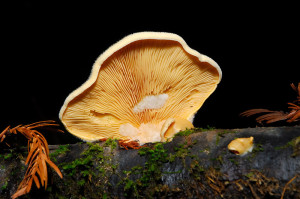
Phyllotopsis nidulans
The Mock Oyster is distributed widely across North America and Europe, although reportedly somewhat rare in the Pacific Northwest[1], and can usually be found clustered on decaying hardwoods and conifers from fall to late winter.
Like most fungi found here, the Mock Oyster is an agaric, a gilled mushroom species.
Although similar in shape, it is distinctly different from a true oyster mushroom in its coloration. Even from a distance, the bright apricot-orange color of the cap and gills make this species stand out from the drab greens and browns on the forest floor near the creek.
The spore print of this species is pink. Even though the spores, and flesh, of this mushroom species are brightly colored though, Phyllotopsis nidulans is reportedly of little to no value as a dye.[2]
Some report this species to have a particularly offensive skunk-like odor, but these specimens weren’t particularly aromatic. They were however, otherwise typical of the species.
The caps are stemless, growing up to 8 cm in diameter, and somewhat kidney-shaped.
The fans have inrolled margins when young, and become more plane to convex with age.
Aside from their unique color, the dorsal surface of the fan-shaped caps are noticeably hairy, unlike the true oyster mushrooms. This gave rise to the species name nidulans, which is Latin for ‘nesting’, due to the downy almost nest-like caps.
The first part of our winter was promising for fungi, and we’ve found some interesting species so far, but since late November we’ve been entrenched in the midst of persistent high pressure attributed to our La Niña weather pattern, making fungi few and far between. Unless our rains return soon, Mushroom Mondays for the remainder of the season may find themselves in jeopardy.
On the upside though, it’s another great day to head out to the garden!
————–
[1] Trudell, S., and Ammirati J. 2009. in Mushrooms of the Pacific Northwest. p. 139. Timber Press.
[2] Bessette, A. R., and Bessette, A. 2001. in The Rainbow Beneath My Feet: A Mushroom Dyer’s Field Guide. p. 164. Syracuse University Press.

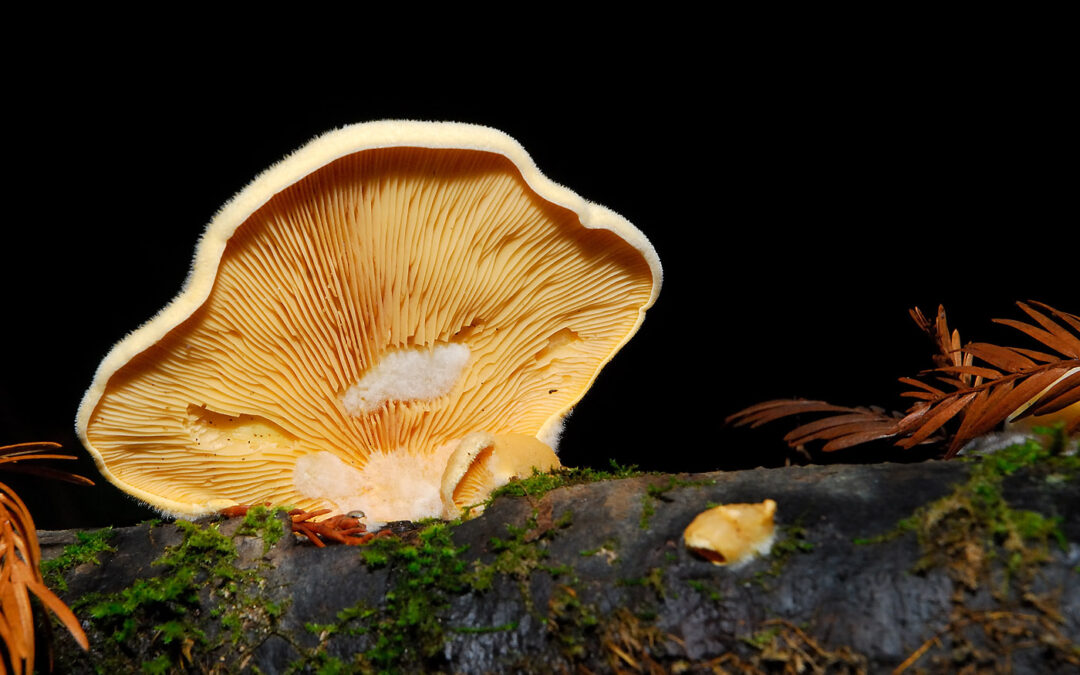
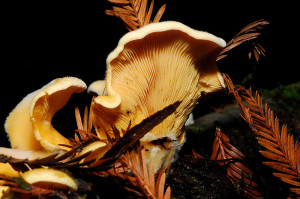
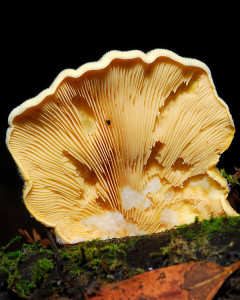

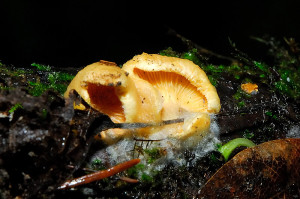
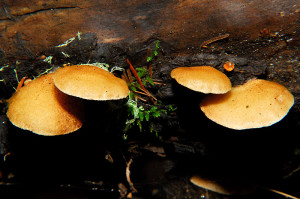








How fun to walk beside on your awesome grounds … you, the fine teacher, Clare, and me … with so much to learn! Happy New Year 🙂
Oh, I have much to learn too! Happy New Year Joey! 🙂
I never realised that there could even be such a thing as a smelly mushroom……never mind one that was so fuzzy.
The weather is really strange here aswell – I ended up gardening on Saturday – the first bit of gardening in January I’ve done in 10 years.
Oh, there are some very fetid fungus species out there. This wasn’t very aromatic, perhaps due to the recent rain, or the soil it was growing. Some of the most famous fetid fungus though I have yet to find on the property, the appropriately named Stinkhorn fungi, most of which smell like rotting flesh! 😯
Dear Clare, You are so.o.o knowledgeable! If you had told me it was a true oyster mushroom, I would have believed you. Seems we’re having bizarre weather all over the world. P. x
From a distance, I almost thought it was a true oyster. These however look more leathery and fuzzy than the edible variety. They actually didn’t look tasty, but depending on their stage of growth they could be very easily confused.
I love this mushroom. I wonder if that is the fungus on my white ash stump. It is the first picture on my current blog post…
I couldn’t quite tell if yours was or not. I kept wanting to flip the photo over so I could see underneath! 😛
I like your photographs. Mushrooms make such great photo subjects. I really like the last image where it is enveloping the other plant. It looks like it is in a horror movie… run plant… too late.
Mushrooms are fun photography subjects, although as they like to grow in dark places, it can be challenging to get the lighting right! Also, being low to the ground, I invariably end up with muddy knees for my efforts 😛
Dear Clare thank you for the warning. I shall beware the false oyster.
I think if one ever accidentally tried to eat one, the texture would alert the consumer to the difference! They are truly beautiful though, I’m always in awe of the fabulous array of colors in the world of fungi.
Hi Clare – They may not be edible but they certainly make a great photographic subject. I love the photo of the mushrooms amongst all the leaf litter – wonderful capture. You have such interesting things going on on the farm … wonderful! And thanks for always sharing with us all.
Our leaf litter is so drab that these really popped when I first saw them. I was probably about 15-20 feet away when I spied them, they were that noticeable. I wish all fungi were that easy to find here…especially morels! 😛
Always fascinated by the beauty of mushrooms. Wish they are all edible 🙂
I wish they were too, but sadly they’re not! We seem to have a near endless supply of mushrooms here in the winter months (well, when it rains that is). With the annual Fungus Fair in Santa Cruz this weekend, I’m wondering if they’ll be able to find enough specimens, it’s been so dry!
Interesting post on a pretty mushroom! Lots of rain here. I have been frustrated, as the temperature is mild but I still can’t get any work done in the garden on my off days.
With your mild weather, and all that rain, I suspect you might have some fabulous fungi popping up in your woodland garden. We’re crossing our fingers for rain here soon, I’m getting frustrated having to water the garden so much in WINTER! 😯
You’re lacking in moisture there as well? We are distinctly lacking this year in terms of snow, who knows how the plants will survive this year. I wonder how a season lacking in mushrooms will affect the ecosystem in your area. Will the spores simply remain below ground and wait?
We also have a lot of mushrooms here during the wet season, I am also amazed and excited to see them. However, i don’t know much about mushrooms, I mostly know only those edible ones.
Very interesting mushrooms. You are fortunate to live where there are so many varieties. We may get more next week,…rain expected…